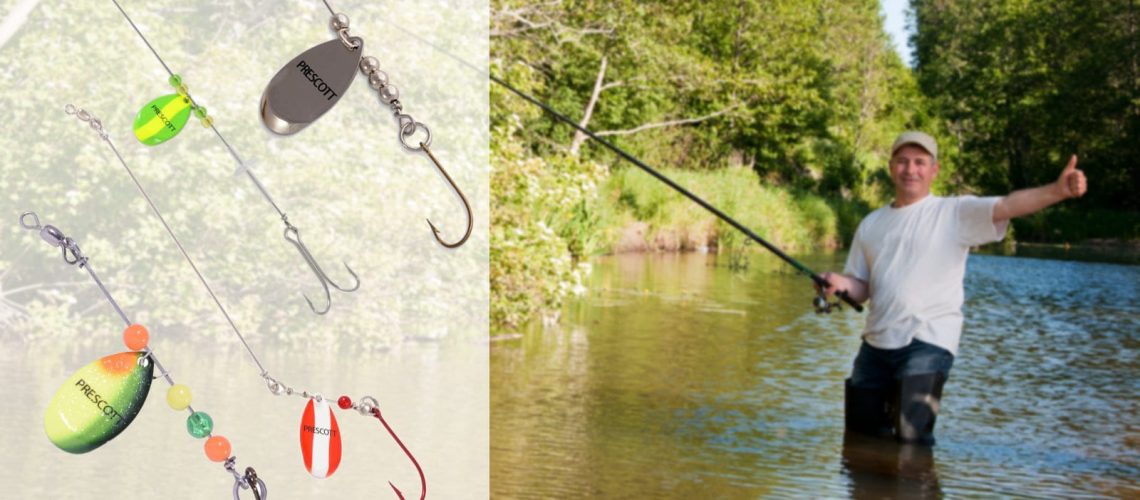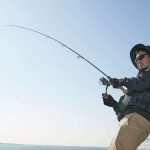Fishing spinners are useful lures that every good fisher should have in their tackle box. Spinners are made out of a thin metal plate with a hole in one side to attach to your lure wire. Although they come in different sizes and shapes, they usually look somewhere between a teardrop and an oval.
These similar shapes are designed to spin at different speeds when you pull them through the water. The spinning creates flashes of reflected light as well as vibrations that ripple through the nearby area. To a predator fish, these signs look like delicious small prey that they can eat.
Spinners can catch most kinds of game fish in many different conditions. In clear or translucent water, the flashes are almost irresistible to nearby hungry fish. In muddy or dark water, fish on the prowl are attracted to the revolving blade’s vibrations.
Even if you’re a beginner, it’s pretty easy to learn to use a spinner. You don’t need a complicated hooking technique because the fish will usually strike the spinner hard enough to get itself hooked. Then all you need is a steady straight retrieve to get it back to the land or the boat.
A basic spinner lure attaches to your line just above your hook or lure. Most fishermen add a small weight to make sure it’s heavy enough to cast properly.
You can use a spinner for surface fishing if you attach a buzzbait propeller to help it skim across the surface. Some kinds of spinnerbaits use more than one spinning blade to attract more attention. You can even use a spinner with a live bait hook setup.
Blade Styles of Fishing Spinners
The spinner’s blade’s shape determines how much resistance it creates as you pull it through the water. The amount of resistance determines its unique pattern of flashes and vibrations. It also determines how deep the spinner will run.
From widest and shortest to thinnest and longest, the seven most common blade styles are the Colorado, Indiana, Indiana Fluted, Turtle Back, French, Inline, and Willow. The wider the blade, the shallower it will run and the more vibrations it will produce.
The short and squat Colorado is the loudest spinner and the best for fishing shallow waters. The long and thin Inline and Willow spin at a tighter angle to your wire shaft, which allows them to run deeper and quieter. The tight angle also lets you retrieve them faster and makes it harder for them to get caught up in underwater litter and plant life. The mid-range models are each designed for their respective intermediate depths.
Fishing Spinner Blade Sizes
You can get any of these spinner styles in various sizes, generally numbered from zero to 10. The smallest sizes work great for stream trout. Bass bite better when you use sizes three to five. The bigger sizes are made for catching muskies and other monsters.
Fishing Spinner Blade Colors
Spinners come in different colors for different fish and fishing conditions. Metallic colors like gold, silver, and copper make a spinner flashier and more attractive to predators that hunt via sight. Spinners with a painted finish are less flashy but provide higher contrast underwater, which works better in muddy areas or darker weather.
Accessories
Some fishermen like dressing their spinners up a bit to suit specific fishing conditions. Animal fur and feathers have been used for decades as traditional spinner dressings. Red feathers are especially irresistible to certain kinds of fish.
In recent years, fishers have started adding synthetic dressings like skirts made from silicon and flashabout. You can get these in solid or incandescent colors to increase the flash.
There are also soft plastic dressings made to look like minnows or grubs. These are known as trailers and are generally painted to look as lifelike as possible.
If one spinner isn’t enough for you, you can also find styles that come with double blades or more. An inline spinner with at least two metal blades is called a bulger. When you reel it in quickly, it tends to ride high in the water. It often creates a slight bulge in the water’s surface tension and sometimes even breaks the surface at fast enough speeds.
When you use a spinner with two tandem blades, it reflects twice the light resulting in double the flashes. To underwater predators, this can look like a whole school of tantalizing baitfish, which can drive them to strike hard.
Anything you tie to your spinner’s tail will give it more resistance and lift, making it slower to retrieve. Dressings are fun, but if you’re looking for speed or depth, an undressed spinner will give you the best performance.





